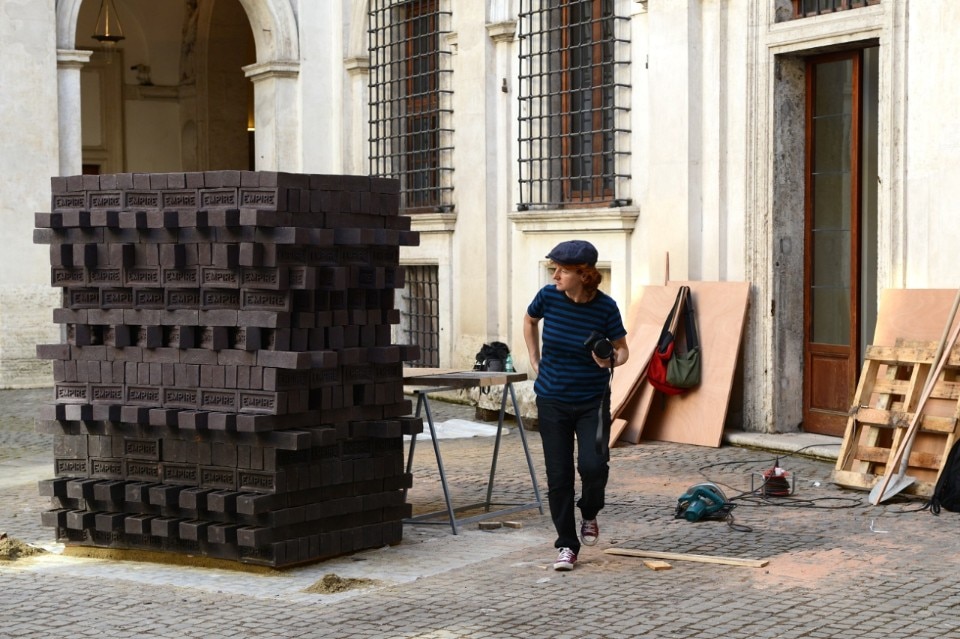On the occasion of her last sculptoral project, titled EMPIRE and installed in Rome at the National Roman Museum, until September 1st, Elisabetta Benassi (1966, Rome) examines in depth connections and traces disclosed among her most recent works, suspended in a closer future.
Your last solo show, in Paris was entitled The Sovereign Individual. Which kind of notional imaginaries, which kind of speculative notes, which further imaginaries the show has offered to anticipate or to get into EMPIRE (2019)?
Elisabetta Benassi: In order to talk about EMPIRE, I should initially mention a project I realized in Reggio Emilia, at Collezione Maramotti. It occurred before the 2018 exhibition I had in Paris. For me, exhibitions are more important than each single work, they always allow me to articulate an idea in a more complex way. The entire solo show in Reggio Emilia was inspired by a past controversy. It was about a fact occurred in the 1970s: an acquisition promoted by Tate Modern and related to a fragment of an installation by the American artist Carl Andre. The title was Equivalent and it was articulated around exhibitive displacements. The focus was voted to enhance Maramotti Collection, inside the oldest factory of Max Mara fashion brand. Among the works I realized, on such occasion, there was Infinity, in which I first made use of Empire’s bricks.
In 1986, Carl Andre realized a work entitled Manifest Destiny where he overlay eight bricks bearing the trademark of an American furnace -actually disappeared-, a furnace called Empire. Bricks were overlapped, precariously in balance.
In Infinity, the main idea was to extend the column up to the ceiling, where a pair of big yellow work-gloves positioned and stuck it, accentuating its sense of precariousness evn more. The title was an obvious tribute to Brancusi and once more to Carl Andre who was greatly influenced by Brancusi, at the beginning of his career. Bricks, constructive element of Infinity and Zeitnot (in this case devoid of the word Empire), evoke the industrial age and the decline, recalling the idea of progress and becoming a means to submit other questions. In Zeitnot, bricks assemble forms that are difficult to describe, as bunkers, for instance, or even fantastic constructions and shelters.
Sovereign Individual drew its title from the book of one of the most tenacious English neoliberals, an ardent Brexit supporter, Jacob Rees-Mogg, who figures a world out in which every idea of community has disappeared and the "sovereign individual" rules over a hypercompetitive world. The three large plaster shelters installed in Paris, as well as the habitable shells equipped with doors, are precisely precarious shelters for the last "sovereign individuals", actually dealing with a possible apocalyptic future.
In your recent practice, could you please list three imaginary solutions conceiving your clearest form of resistance -of balance- in front of two chaotic dimensions such as individual salvation and collective catastrophe?
I would say that there are, at least, two imaginary solutions: one is accurately about the individual shelters. The second one is related to time and, especially, to the utopian chance of escaping Capitalism time of production, throughout an altered level of consciousness and a time suspension. But those are just solutions, only determined by an ironic sense of humour. They are ways to solve the problem. I am not interested in providing solutions, but in glimpsing the emptiness that surrounds us, making people feeling the urgency of finding non-illusory answers, non-sentimental point of views.
From ViceVersa (2013), to The Dry Salvages (2013), to Equivalenti (2014), getting through It Starts with the Firing (2017), Shadow Work (2017) and Zeitnot (2017) which kind of interpretation does the symbol of brick assume? And what does it represent in EMPIRE (2019)?
The choice of entail bricks simbolically does not refer to specific style criteria, connected, on another side, to a simple formal preference. I use bricks because they represent a basic constructive unit, essential but also ancestral, an element whose function could not be misinterpreted. Exactly like the atom's definition: it is elementary but extremely powerful, fragile but also enduring; becoming long-lasting and continuous when it joins similar components.
In fact, if some units are removed from the “wrong” places, the whole structures collapse, while chaos and entropy create fundamental conditions, which cannot be omitted by history. Bricks could also evoke a metaphor related to our society, to all individuals within our society, to our personal stories as well as to a human, universal history.
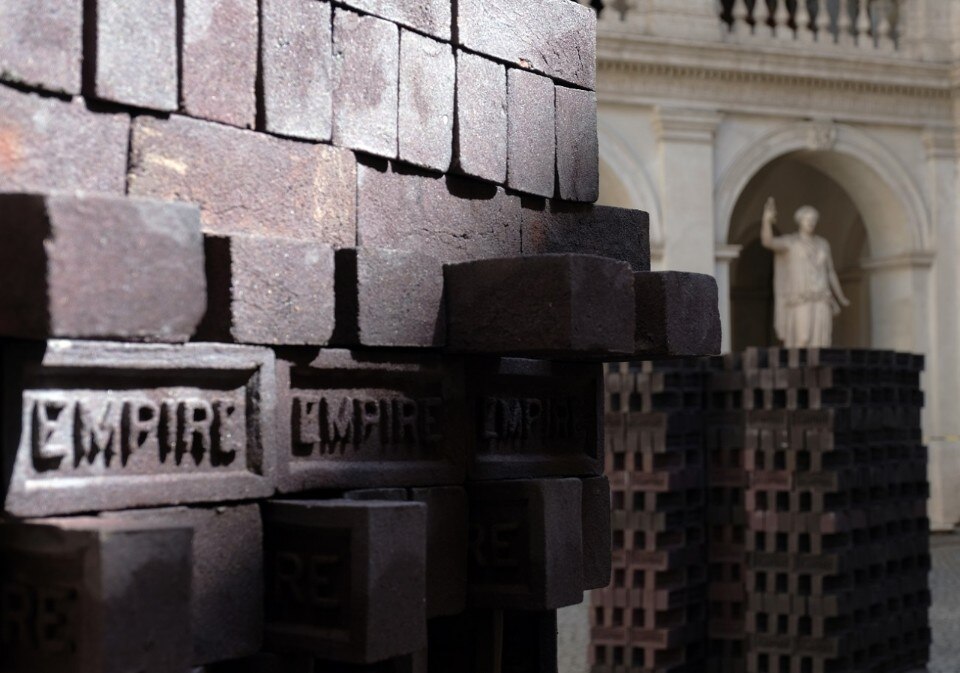
Every time you used bricks, as a minimal structural unit for building a space up -inside a larger space characterized by time- you also graft the doubt of a building fragility. Is EMPIRE (2019) strictly related to this concept?
Yes, I foster bricks' uses also for such a reason: because I just could handle them dry, without applying mortar, in balance against gravity and, therefore, pondering the possibility of dismantling an existent structure up to a single unit.
Representing a basic unit of each wall in the world, brick is linked to the size of human hands intrinsically. Embodying the basic size of a bricklayer, of a building worker. Human hands results a measure unit for both the building and the human work, and it’s also the essential component to reconsider it as a “tool”, fundamental for its creation from clay: all the bricks I use are hand-made, according to traditional handcrafted techniques.
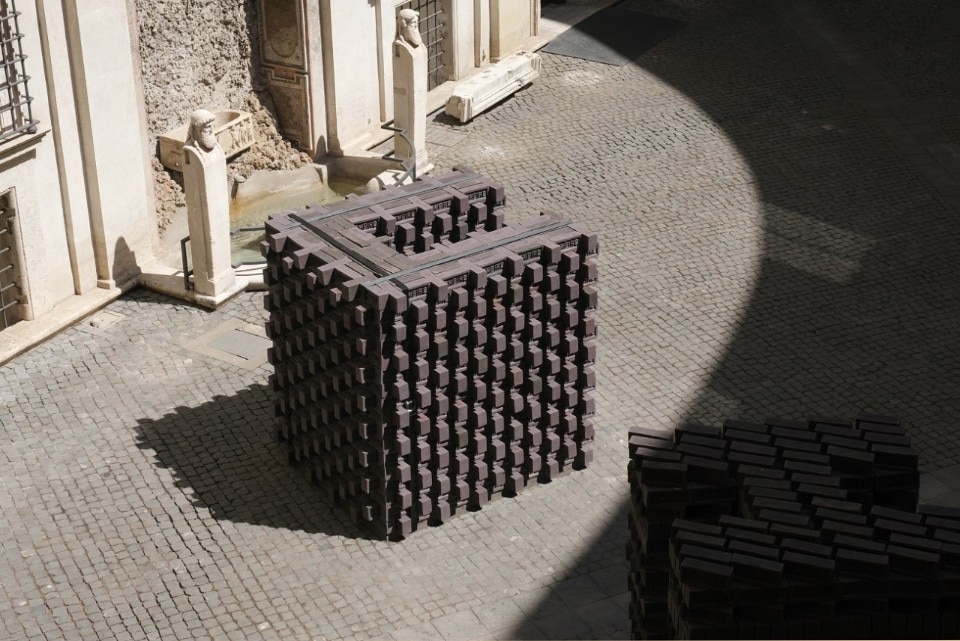
Where does the idea of this new installation come from and which kind of dialogue it intertwines, develops, enhances with National Roman Museum?
Any possible connection, relationship created with the National Roman Museum and ancient art allows me to challenge myself, because it concerns a larger, stratified and deeper time to work on. It also shapes a more ambitious project, avoiding to relate myself directly to a monumental attitude or intervening in a merely aesthetical way. Each work belongs to its own time, a non-linear time. Quoting Gabriele Guercio: “artworks are caesuras breaking and bending the arrow of time”.
Moreover I was deeply keen on a referring environment: the city of Rome. It represents an opportunity, for me, of being able to measure myself. I'm facing what my city symbolises, for better or for worse. Today the bricks are even more politically connoted: the empire we are currently facing is no longer just a previous one, but it's an even wider, immaterial, pervasive form of dominion, ruling our world. The destruction of welfare, the growth of poverty and inequality, unemployment, wars, create millions of victims and billions of exploited people. EMPIRE’s black bricks establish simple, temporary, aggressive shapes; they all create a sort of a skirmish with the white sculptures of the Museum and with the spectator. They look like basements voted to support weird giants: they are solid but at the same time they also could still fall.
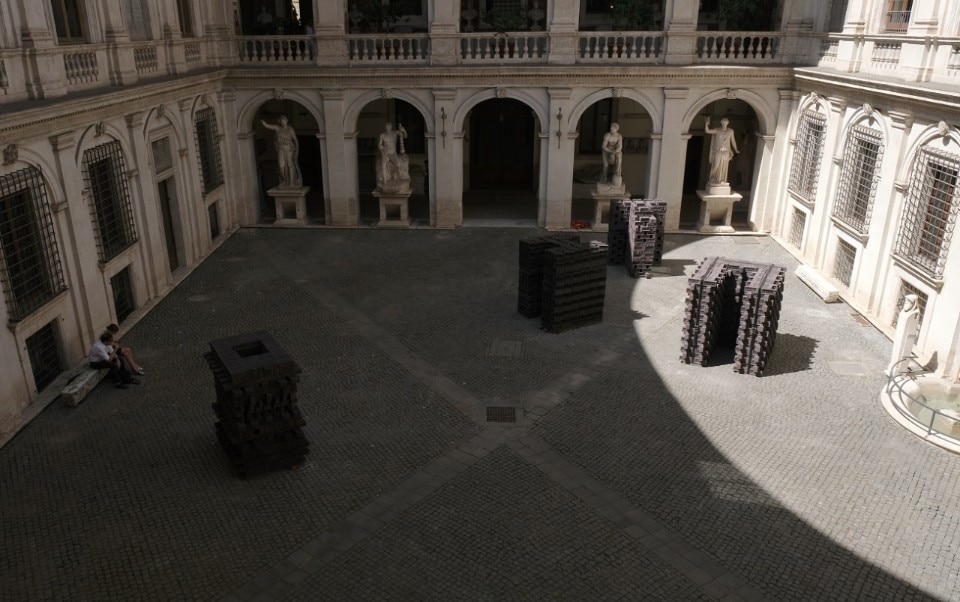
The term Empire - a clear reference to Andre – which kind of historical and political landscapes does it evoke?
The term includes several historical, political, economic, military, social resonances; they are not limited to ancient times, and on whose nature, starting from the colonialist, fascist, or even more ruthless repetitions of contemporary imperialism. On the contrary, it concerns artistic reflections gathered with great relevance.
I think that past and present should be glimped not in a linear but in a dialectical way; that's why I tried to imagine how, in a thousand years, a work made of black bricks, inside a Roman brick building, would be acknowledged. No one, perhaps, would ever think about reading a trademark realized by an American furnace, a Carl Andre’s oeuvre or even by me. Will it be considered a testimony of our age? Will it be not appreciated or will it be considered irrelevant? Which kind of further empires will get in dialogue with EMPIRE?
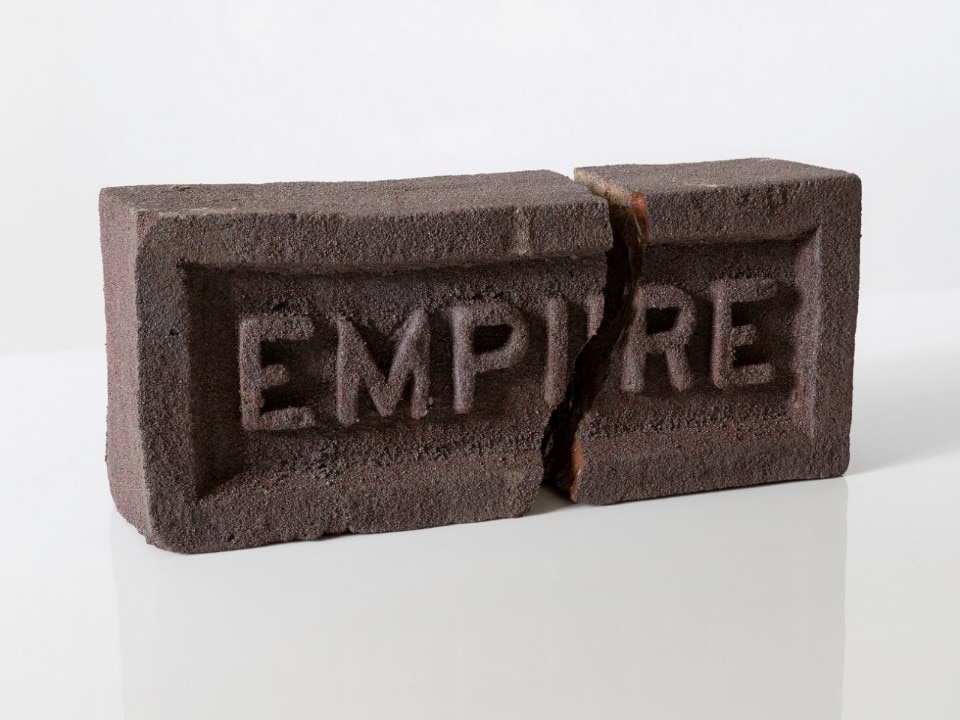
How did such installation join the international program and the call for proposals of the Italian Council (2018), a competition conceived by the Directorate General for Contemporary Art and Architecture and Urban Suburbs (DGAAP) of the Ministry for Cultural Heritage and Activities?
EMPIRE is a way to rethink the relationship between antiquity and contemporary era, inscribed within a critic dimension. I tried to obstruct the Classic models that we always think to know instinctively, by heart. I was aiming to turn it into a different perspective, as a form of friction and resistance, against the presumed automatisms of our present.
Why 6000 bricks represent the exact number of elements composing EMPIRE (2019)?
The weight of six thousand bricks is related to the maximum capacity of a lorry, it's about twenty-five tons. Moreover six thousand was the number of soldiers constituting a Roman legion.
In your view, EMPIRE (2019) could reveal a sort of hypostatization, a solidification of a performative gesture that you deepened in M’Fumu (2015), perpetrated in Corsaro (2014) and entrusted, ideally, in Nevermore (2008)?
Actually we could consider it an action, a performance, like the construction of a barricade, or a shelter. A feature offered also by its temporary and site specific nature. It's not clear, among the four different configurations of the work, which one is going to be built or which one is going to be dismantled. Such changeability contributes to bestow it on its performative aspects.
Could you please formulate a message, a statement guiding EMPIRE (2019) through?
More than a thought, I’d rather to express a wish for those who see it: please ponder it, just considering the whole of its aspects, even though they could not seem predictable.
- Exhibition Title:
- Elisabetta Benassi. EMPIRE
- Opening dates:
- From June 21 to September, 2019
- With the support of:
- Italian Council Directorate-General for Contemporary Art and Architecture and Urban Suburbs (DGAAP) of the Ministry of Cultural Heritage and Activities, led by Federica Galloni.
- Venue:
- Museo Nazionale Romano. Palazzo Altemps
- Address:
- via S. Apollinare, 8 00186, Rome


